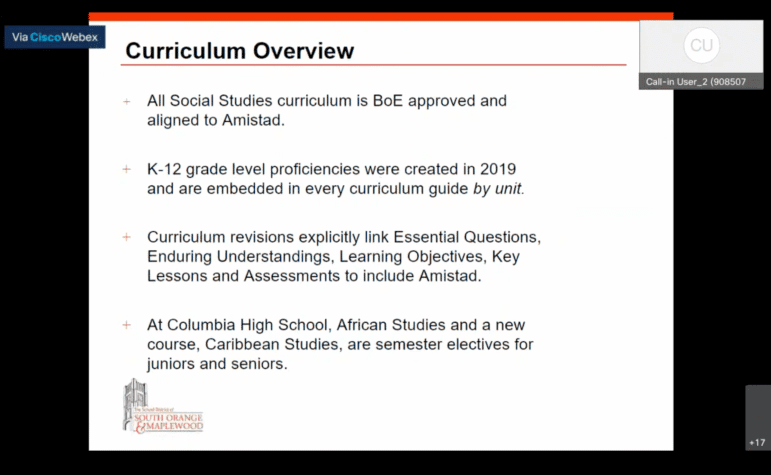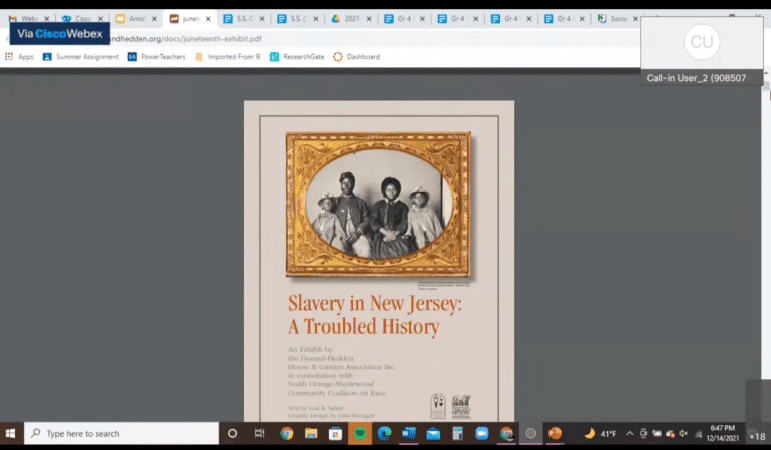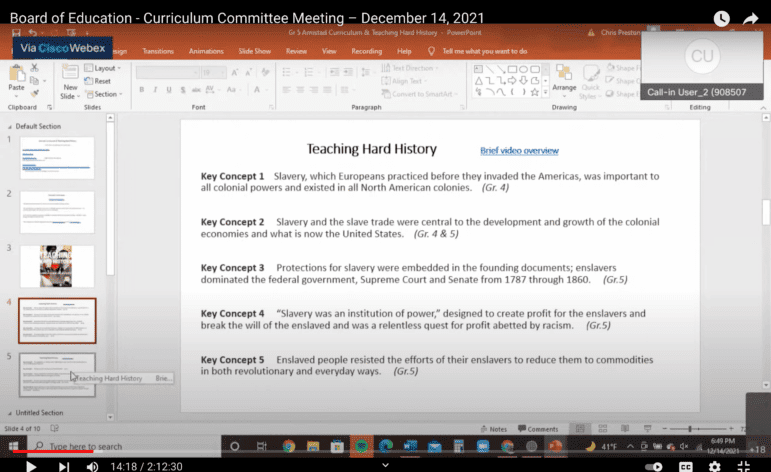After years of work, the South Orange-Maplewood School District is fully integrating African-American history into social studies courses at every grade level, according to an update from the district’s K-12 Social Studies Supervisor.
Members of the Curriculum & Instruction committee heard the presentation from Christopher Preston on Tuesday night, outlining how the district is teaching social studies according to the guidelines of the New Jersey Amistad Commission. The changes went into effect at the beginning of the 2021-22 academic year.
The SOMSD Board of Education approved all curricula and it is aligned to Amistad, Preston said in his update. Preston, who created grade-level proficiencies in 2019 for the curriculum, said that those proficiencies are now embedded in every curriculum guide by unit.
The Amistad Bill, which became state law in 2002, “calls on New Jersey schools to incorporate African-American history into their social studies curriculum” using “materials and texts which integrate the history and contributions of African-Americans and the descendants of the African Diaspora.” The bill also created the Amistad Commission, a 23-member body responsible for ensuring the curriculum is “adequately taught in the state’s classrooms,” according to the Amistad Commission’s page on NJ.com.

Preston said at the outset that the Amistad Bill allowed individual school districts to make tweaks to its suggested curriculum, and that SOMSD had gone “a step further than the state provided” in terms of specific lesson plans by grade level.
For example, beginning in fourth grade, SOMSD students will address topics “with a specificity that is Afro-centric, Atlantic-world-centric, and [gets] away from a western-dominated narrative,” Preston said. Fourth graders will be taught that European colonizers arrived in Africa and the Americas and found already-thriving societies there. Fifth graders will have an introductory lesson about the nature of history and understanding whose story is taught and whose story is not, and the importance of learning about those excluded from the story.
Preston noted that the New Jersey state curriculum named only four specific people in a grade-school history unit: Thomas Jefferson, Benjamin Franklin, George Washington, and William Livingston, who served as New Jersey governor during the Revolutionary War and was a signor of the Constitution. “That is it,” he said. “We were looking early on in history to give students names and events and their stories to really teach the larger narrative that we want to portray.”

SOMSD students will learn the names of Black historical figures like Harriet Tubman and Nat Turner and their stories as well as those of white abolitionists during this unit, Preston said.
Another change, Preston said, involved giving students a global perspective that would help them better understand, for example, the transatlantic slave trade. “World history,” Preston said, “is largely absent from the K-5 curriculum.” He said students in fourth and fifth grades would be introduced to the history of Africa and to the scale and impact of the slave trade, then revisit it in 8th grade.
In high school, Preston said, a focus would be on “race as a social construction and delving deeply into topics of race and racism.”
Professional development for teachers, Preston said, is key to the implementation of the Amistad curriculum throughout the district. Grade-school teachers read a “instructional framework” by an organization called Learning for Justice called Teaching Hard History: American Slavery and discussed the concepts within. Teachers also requested the creation of a resource bank – a “one-stop shop” – where they could access all resources from professional development sessions, and Preston is in the process of building that, he said.

Board member Courtney Winkfield applauded the use of professional development in the implementation of the Amistad curriculum. “I’m curious how the district is using additional professional development to ensure that there is a link between what we’re expecting our history teachers, in particular, to teach in the Amistad curriculum and how we expect them to utilize the tools in these implicit bias and cultural competency trainings so that they feel prepared for what may come up in the classroom and also feel empowered to address some of what the students bring up?” Winkfield asked.
Preston offered to follow up with Winkfield in the spring on the link between implicit bias and Amistad training. He said that fifth-grade teachers were walked through “potential pitfalls” before they taught about slavery and other aspects of the Amistad curriculum.
Board member Annemarie Maini asked Preston if parents had access to the Amistad resources. Matthew Friedman, the SOMSD Assistant Superintendent of Curriculum & Instruction, said that a lesson-plan repository available to parents was part of a “future phase” of Atlas. Preston said he would “take the lead” on making plans available to parents in Atlas and Canvas.
Ann Bodnar, SOMSD Director of Curriculum, said that the Amistad curriculum was publicly available in Atlas.
Board member Shannon Cuttle questioned whether there was a “clear understanding” of the intersectionality of the district’s various curricula, including Amistad as well as those supporting LGBTQ, AAPI, and disability rights. “I want to be mindful of that, and making sure that we’re not just trying to check off benchmarks for curriculum diversity but we are showing true intersectionality.”
Friedman said Atlas could be used to run reports on where and how often the various curricular standards are used. “If there are gaps that we’re finding,” he said, “ we can cover them with supervisors.”
Board member Elissa Malespina questioned how parents would know if the standards were actually being taught in the classroom without lesson plans available to them. “Just because the standards are in the curriculum doesn’t mean they’re actually being taught in the curriculum,” Malespina said.
“That’s true,” said Friedman in response. He said that adding the lesson plans to Atlas was “always a year two” project. “As we drill down to the lesson-plan level, one of the things we need to look it is that there is no common lesson plan template in the district,” he said. “We need to come to some sort of consensus” about putting that into Atlas. He said he hoped that would happen during the spring session, and that parents could get a “more granular read” on how the standards were taught.

